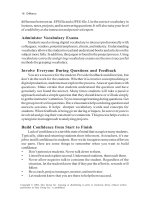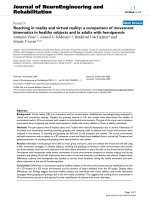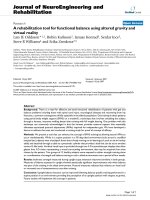Lecture computer graphics and virtual reality slides lesson 3 basic entity algorithms
Bạn đang xem bản rút gọn của tài liệu. Xem và tải ngay bản đầy đủ của tài liệu tại đây (1.05 MB, 38 trang )
Lesson 3
Basic entity algorithms
Trinh Thanh Trung School of ICT, HUST
Content
1. Line representation
1. DDA algorithm
2. Bresenham algorithm
3. Mid-point algorithm
2. Circle & ellipse representation
3. Character representation
Rasterization: Background
■ Converting a continuous object in the world into
a discrete object in the computer
■ We need to lit the pixels instead of drawing a
continuous line
1.
Line representation
Line drawing P(x2 , y2)
■ Line representation u
y = k x + b
P(x1, y1)
with
m
k = (y2-y1)/( x2-x1)
or
𝑦 − 𝑦1 = 𝑦2 − 𝑦1
𝑥 − 𝑥1 𝑥2 − 𝑥1
(explicit form)
Line drawing
■ From linear algebra
y = k x + b
■ Simple approach:
1. increment x
2. calculate y
3. cast y to an integer
4. draw (x, (int)y)
PROBLEM?
Problems
■ It seems to work okay
for lines with a slope of 1
or less
■ Doesn’t work well for
lines with slope greater
than 1
■ Lines become more
discontinuous in
appearance
■ We must add more
than 1 pixel per column to
make it work.
DDA algorithm
■ DDA = Digital Differential Analyser
■ Treat line as parametric equation in t
□ Start point (x1, y1)
□ End point (x2, y2)
■ From linear algebra
y = k x + b
□ When 0
yi+1 = yi + k
DDA algorithm: Pseudo code
ddaline(x1, y1, x2, y2)
begin
m =(x2-x1)/(y2-y1);
x = x1;
y = y1;
k = 1/m;
putpixel(x,y);
while x
x = x+1;
y = y+k;
putpixel(x,round(y));
end;
end;
DDA algorithm: General algorithms
■ Choose appropriate value
for the number of steps (n)
■ Start at t = 0
■ At each step, increment t by
1/n
■ Ensure no pixels are missed:
□ Implies: and
■ Set n to maximum of dx and
dy
DDA algorithm: General algorithms
ddaline(int x1, int y1, int x2, int y2)
{
float x,y;
int dx = x2-x1, dy = y2-y1; n – range of t
int n = max(abs(dx),abs(dy));
float dt = n, dxdt = dx/dt, dydt = dy/dt;
x = x1; y = y1;
while(n--) {
point(round(x),round(y));
x += dxdt;
y += dydt;
}
}
DDA Algorithm: Cons
■ Need a lot of floating point arithmetic.
□ 2 ‘round’s and 2 adds per pixel.
■ Can we use only integer arithmetic?
□ Easier to implement in hardware.
Bresenham algorithm
■ Developed in 1962 at IBM
■ Uses only integer addition, subtraction and bit
shifting, all of which are very cheap operations in
standard computer architectures
■ Chooses the integer y
corresponding to the pixel
center that is closest to the
ideal (fractional) y for the 2 d2
same x; on successive
d1
columns y can remain the 1
same or increase by 1 0
0 12
Bresenham algorithm: pseudo code
d2 = y - yi = k(xi +1) + b - yi
d1 = yi+1 - y = yi + 1 - k(xi + 1) - b
■If d1 d2 => yi+1 = yi + 1
else d1 > d2 => yi+1 = yi
■D = d1 - d2 = -2k(xi + 1) + 2yi - 2b + 1
■Pi = xD = x (d1 - d2)
Pi = -2yxi + 2xyi + c
Pi+1 - Pi = -2y(xi+1 - xi) + 2x(yi+1 - yi)
■If Pi 0 yi+1 = yi + 1
Pi+1 = Pi - 2y + 2x
■If Pi > 0 yi+1 = yi
Pi+1 = Pi - 2y
P1 = x(d1 - d2)
P1 = -2y + x
Mid-point algorithm
■ At step p, assume pixel (xp, yp) was lit
■ Check where the line intersects with x= xp+1
■ Lit (xp+1, yp) or (xp+1, yp+1) , whichever is
■ closer to the intersection
Mid-point algorithm
■ With the implicit form of a line
ax + by + c = 0
■ For every (xi , yi)
axi + byi + c = 0 (xi , yi ) on line
axi + byi + c 0 (xi , yi ) above line
axi + byi + c 0 (xi , yi ) below line
Mid-point algorithm
■ Assume slope is less than 1 and current pixel is
(xi, yi)
■ Next mid-point will be (xi + 1, yi + ½)
■ We calculate di (called decision variable)
1
di = a(xi +1)+ b yi + + c
2
Mid-point algorithm
■ If di > 0: Mid-point is below line
□ A will be chosen
■ If di < 0: Mid-point is above line
□ B will be chosen
A
Previous M Choices for
Pixel B Next pixel
(xi,yi)
Choices for
Current pixel
Mid-point algorithm
■ If A is chosen: We update the decision variable
3 3
xi + 2, yi + di+1 = a(xi + 2)+ b yi + + c
2 2
= di + a + b
A
Previous M Choices for
Pixel B Next pixel
(xi,yi)
Choices for
Current pixel
Mid-point algorithm
■ If B is chosen: We update the decision variable
1 1
xi + 2, yi + di+1 = a(xi + 2) + b yi + + c
2 2
= di + a
A
Previous M Choices for
Pixel B Next pixel
(xi,yi)
Choices for
Current pixel






![mathematical foundations of scientific visualization, computer graphics, and massive data exploration [electronic resource]](https://media.store123doc.com/images/document/14/y/up/medium_upb1401358803.jpg)


